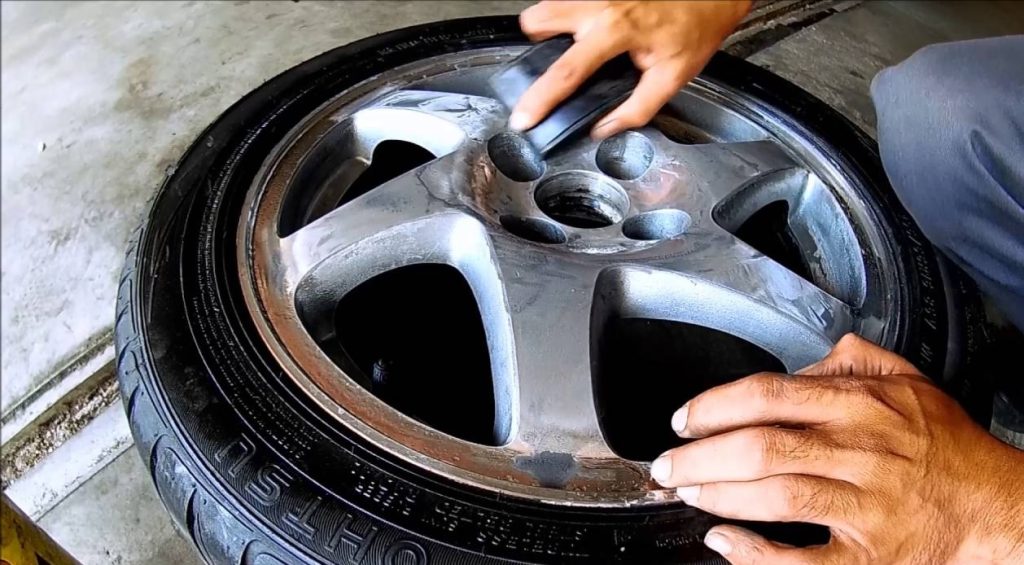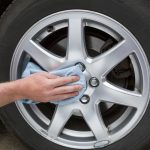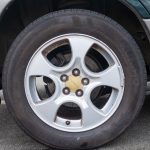Aluminum wheels, with their sleek and modern aesthetic, are a prominent feature that can significantly enhance the overall look of any vehicle. However, despite their durability, these wheels are not immune to the inevitable wear and tear that comes with regular use. Over time, scratches, scuffs, and other imperfections can mar the once-polished surface of aluminum wheels. That’s where the importance of the right sandpaper grit comes into play. In this in-depth guide, we’ll explore the nuances of aluminum wheel restoration, providing you with a detailed roadmap for achieving that perfect shine.
Understanding the Basics of Aluminum Wheel Restoration
Aluminum, known for its lightweight nature and corrosion-resistant properties, demands a meticulous approach when it comes to restoration. Before diving into the specifics of grit selection, it’s essential to grasp the fundamentals of aluminum wheel restoration. This knowledge lays the groundwork for a successful sanding process.
The Composition of Aluminum Wheels
Aluminum alloy wheels are typically made from a combination of aluminum and other metals like nickel or magnesium. This composition contributes to their lightweight yet robust structure. Understanding the composition is crucial as it influences the choice of sandpaper grit based on the hardness of the material.
Common Causes of Wheel Damage
Before embarking on the restoration journey, identifying the root causes of wheel damage is key. Factors such as road debris, brake dust, and even the occasional curb encounter can lead to scratches and abrasions. By recognizing these factors, you can tailor your restoration approach to address specific issues.
Assessing the Condition of Your Aluminum Wheels
Before You Begin: Begin the restoration process by thoroughly assessing the current condition of your aluminum wheels. Are there deep gouges, minor scratches, or just an overall dull appearance? This evaluation will guide your selection of sandpaper grit and help formulate a customized restoration plan.
The Importance of Surface Smoothness
Smoothness is paramount when it comes to achieving a polished finish. Even the smallest imperfections can impact the final result. Therefore, a detailed inspection of the wheel’s surface is necessary to identify areas that may require extra attention.
Choosing the Right Grit: A Crucial Decision
Selecting the appropriate sandpaper grit is arguably the most critical aspect of the restoration process. The grit level determines the coarseness of the abrasive particles and, consequently, the aggressiveness of the sanding action.
1. Coarse Grit (40-80): The Foundation of Restoration
For wheels with substantial imperfections and deep scratches, start with a coarse grit sandpaper. This grit range allows for the quick removal of layers of damage, preparing the surface for subsequent finer sanding.
2. Medium Grit (100-150): Smoothing Out the Rough Edges
Once major imperfections are addressed, transition to medium grit sandpaper. This level of grit smoothens the surface, refining the restoration process and preparing it for the subsequent stages.
3. Fine Grit (180-240): Polishing for Precision
To achieve a polished finish, switch to fine grit sandpaper. This stage focuses on removing minor scratches and further preparing the aluminum surface for the final touches.
4. Very Fine Grit (320-400): The Quest for Perfection
For a flawless, almost mirror-like finish, use very fine grit sandpaper. This final step is crucial for enhancing the overall aesthetics of your aluminum wheels and achieving a level of perfection that catches the eye.
The Sanding Process: Step by Step
With the grits identified, it’s time to delve into the nitty-gritty of the sanding process. This step-by-step guide will walk you through each stage, ensuring a meticulous and effective restoration.
Step 1: Surface Preparation
Before commencing the sanding process, ensure the wheels are thoroughly cleaned to remove dirt, brake dust, and other debris. This initial step sets the stage for effective sanding without the risk of causing additional scratches.
Step 2: Coarse Grit Sanding
Begin with the coarse grit sandpaper. Using a consistent, circular motion, focus on one section of the wheel at a time. The goal is to address major imperfections and create a smoother foundation for subsequent sanding. (See Also: Does Clay Bar Remove Clear Coat? Learn the Truth About Automotive Detailing)
Step 3: Medium Grit Sanding
Transition to medium grit sandpaper, maintaining the circular motion. This step refines the surface further, smoothing out rough edges left by the coarse grit sanding. Pay close attention to detail, as precision is crucial in this stage.
Step 4: Fine and Very Fine Grit Sanding
Continue the process with fine and very fine grit sandpaper, respectively. Each step in this progression contributes to a smoother finish, removing smaller imperfections with precision. The very fine grit sanding, in particular, is instrumental in achieving that coveted mirror-like shine.
Tips for a Successful Restoration
While the sandpaper grit plays a pivotal role in the restoration process, certain tips can enhance the overall effectiveness of your efforts.
1. Patience is Key
Taking your time at each grit level is paramount to ensure a thorough restoration. Rushing through the process may result in uneven surfaces and compromise the final result.
2. Use Quality Sandpaper
Investing in high-quality sandpaper is essential for achieving the best results. Cheaper alternatives may not provide the precision required for aluminum wheel restoration, potentially hindering the overall outcome.
3. Protect Surrounding Areas
Covering nearby surfaces and parts of the vehicle is crucial to prevent accidental damage during the sanding process. Taking precautions ensures that your efforts are focused solely on restoring the wheels without causing unintended harm.
4. Consider Wheel Coating
After the sanding process is complete, consider applying a protective coating to the wheels. This additional step can help preserve the restored finish and guard against future damage.
Expert Tips for Optimal Aluminum Wheel Restoration
Restoring aluminum wheels to their former glory requires more than just choosing the right sandpaper grit. Follow these expert tips to ensure a meticulous and successful restoration process that leaves your wheels gleaming.
1. Start with a Thorough Cleaning:
Before diving into sanding, make sure your wheels are free from dirt, brake dust, and debris. A clean surface ensures effective sanding without the risk of additional scratches.
2. Use Progressive Grits Methodically:
Progress from coarse to very fine grits systematically. Each grit level serves a specific purpose in smoothing the surface, so don’t rush through the process. Patience is key to achieving a flawless finish.
3. Inspect for Hidden Damage:
Take the time to inspect every inch of your wheels. Hidden damages or imperfections may be lurking beneath the surface. Identifying and addressing them early ensures a comprehensive restoration.
4. Consider Alloy-Specific Grits:
Different aluminum alloys may have varying hardness levels. Research the specific alloy of your wheels and choose grits tailored to its hardness for optimal results.
5. Invest in Quality Sandpaper:
High-quality sandpaper makes a significant difference in the restoration process. Investing in reputable brands ensures precision and longevity, contributing to a superior finish.
6. Protect Wheel Surroundings:
Cover adjacent surfaces and vehicle parts to safeguard against accidental damage during the sanding process. Prevention is key to a seamless restoration experience. (See Also: How to Remove Fine Scratches from Car Paint: Ultimate Guide)
7. Employ a Balanced Pressure:
Apply even pressure during sanding to avoid creating uneven surfaces. A balanced approach ensures consistent results across the entirety of your aluminum wheels.
8. Experiment with Test Areas:
Before committing to the entire wheel, test different grits on a small, inconspicuous area. This allows you to gauge the impact of each grit level and refine your approach accordingly.
9. Use Lubrication for Finer Grits:
When working with very fine grits, consider using a lubricant to reduce friction and prevent overheating. This step enhances the effectiveness of the finer grits and contributes to a polished finish.
10. Apply a Protective Coating:
Once the sanding process is complete, consider applying a protective coating to prolong the restored finish. This additional layer acts as a barrier against environmental elements and potential damage.
11. Regular Maintenance Matters:
Keep your aluminum wheels looking pristine by incorporating regular maintenance. Routine cleaning and inspection help identify issues early, preventing extensive restoration work in the future.
12. Seek Professional Guidance if Unsure:
If you’re uncertain about the restoration process or encounter challenges, don’t hesitate to seek professional guidance. Consulting with experts ensures a tailored approach to your specific wheel restoration needs.
Embrace these expert tips as you embark on your aluminum wheel restoration journey, and watch your wheels transform into shining examples of automotive elegance.
Frequently Asked Questions About Sanding Aluminum Wheels
Aluminum wheel restoration can be a nuanced process, and questions often arise about the best practices and techniques. Here are some common FAQs to guide you through the intricacies of sanding aluminum wheels.
1. What Grit Sandpaper Should I Start With?
Begin with a coarse grit (40-80) to address significant imperfections. Gradually transition to finer grits as you refine the surface.
2. Can I Use the Same Grit for All Wheels?
The ideal grit may vary based on the condition and alloy of each wheel. Inspect and choose grits accordingly for a tailored restoration.
3. How Do I Prevent Scratching During the Sanding Process?
Thoroughly clean the wheels before sanding, use a lubricant for finer grits, and maintain even pressure to minimize the risk of scratching.
4. Is Sanding Suitable for All Aluminum Wheel Finishes?
Sanding is generally suitable for most finishes, but it’s crucial to test on a small area first, especially if your wheels have a unique or delicate coating.
5. Can I Use Power Tools for Aluminum Wheel Sanding?
While power tools can expedite the process, they require careful control. Hand sanding provides more precision and is recommended for beginners. (See Also: How Much to Wrap a Jeep Renegade: Cost Guide and Expert Tips)
6. How Long Does the Restoration Process Typically Take?
The duration depends on the extent of damage and your proficiency. Plan for several hours, allowing time for thorough cleaning and each grit level.
7. Do I Need to Sand the Entire Wheel Surface?
Focus on damaged or dull areas, but ensure a uniform appearance by blending the sanded sections with the rest of the wheel.
8. What Precautions Should I Take to Protect Surrounding Areas?
Cover adjacent surfaces, brake components, and other parts of the vehicle with protective materials to prevent accidental damage during sanding.
9. Can I Skip Coarse Grits and Start with Finer Grits?
Starting with coarse grits is essential for removing major imperfections. Skipping this step may result in an uneven surface and compromise the final outcome.
10. Is Wheel Coating Necessary After Sanding?
While not mandatory, applying a protective coating after sanding helps preserve the restored finish and shields against future damage.
11. Can I Sand Aluminum Wheels with DIY Materials?
Quality sandpaper is crucial for effective restoration. While DIY materials may work, investing in professional-grade sandpaper yields superior results.
12. What if I Encounter Deep Gouges or Curb Rash?
Deep gouges may require more aggressive sanding and additional steps. Consult a professional if the damage is extensive for tailored advice.
Navigating the process of sanding aluminum wheels involves addressing various concerns. Use these FAQs and answers as a guide to embark on your wheel restoration journey with confidence.
Conclusion: Revel in the Resplendence of Restored Aluminum Wheels
In conclusion, the journey to restoring aluminum wheels involves more than just selecting the right sandpaper grit. It’s a meticulous process that requires a comprehensive understanding of the wheels’ composition, a detailed assessment of their condition, and a systematic approach to sanding.
Embrace the transformation, revel in the resplendence of your restored aluminum wheels, and hit the road with confidence. After all, a little patience, precision, and the right sandpaper grit can go a long way in reviving the allure of your cherished set of wheels. Happy sanding!



